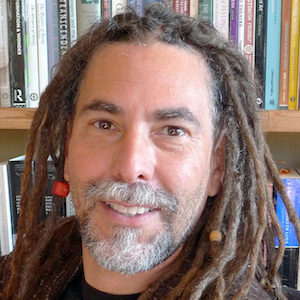Although I am an academic and a scholar by profession, I think of myself as an artist. In the big picture, of course, these labels mean nothing. We are all much bigger than our job titles. Nevertheless, by calling myself an artist – even an artist of ideas – I give myself permission to play; to take pleasure in the processes of thinking, researching, and writing for the sake of pleasure; to make leaps that might soar or might thud, without a concern for whether my playful investigations are useful or saleable, let alone true. So, although I earned a Ph.D. in Buddhist Studies from the University of Michigan in 1996, I have not made expertise in that body of knowledge the chief focus of my professional endeavors. It is important to understand what facts are, how they work, and how to manipulate them with grace and accuracy. But for me academic knowledge-work does not hold much interest as an end in itself. As an author and a teacher, rather, I am dedicated to exploring the intellectual imagination. How does one use knowledge in a disciplined and accurate manner as a medium through which to imagine and pursue possible futures?
These explorations have found their formal expression in two academic monographs. The first, Beyond Enlightenment: Buddhism, Religion, Modernity (Routledge, 2006), focuses on Ajanta, an archaeological site in India famous for its Buddhist caves filled with sculptures and paintings. But rather than limiting itself to questions about Buddhism in its ancestral land, Beyond Enlightenment explores the politics of enlightenment. How do Buddhists and Christians, ancient Indians and modern Europeans, use the ideal of enlightenment to instantiate their own political desires; to make those desires seem natural and righteous, beneficial and valuable for all?
My second book, The Splendid Vision: Reading a Buddhist Sutra (Columbia University Press, 2012), features the first-ever English translation of the “Splendid Vision Sutra,” a sixth-century Indian Mahayana Buddhist scripture known for its rich ritual magic and worship of bodhisattva-goddesses. Intended for introductory courses in Buddhism and general readers, the book uses the Splendid Vision Sutra to open a window onto religious experience and practice in the contemporary world as well as that of the past.
Writing is a joy, but so is performing. Though every successful professor is skilled at stagecraft, I have brought my passion for intellectual play into the realm of circus. As a member of Technomania Circus, and later as a founder and performer with Zirk Ubu, I explored my passion for the transformative possibilities, and perils, of abstract ideals. In particular, I loved to create characters who luxuriate in their own fantasies; who hardly recognize, let alone conform to, social norms. My playful personae included the magic house in love with a chicken; Cliffie, the Disco Shaman; the execrably bad poet; and Peter Henderson, who along with his sister Muffy formed the world's only mixed-sex conjoined twin pair.
It is too soon to say whether my circus days are fully behind me. Presently my creative energies are directed in several other directions. As a long term project, I am writing a book entitled, This Side of Mystery. This book provides a point-by-point guide to intelligent unknowing, that is, to a conscious and creative engagement with one’s own ignorance. There are circumstances when not-knowing feels more true than knowing and when one’s answers do not feel adequate to one’s questions. This Side of Mystery explores such experiences of disjunction, treating them as legitimate and normal, rather than as pathologies of reason or religion.
Another recent project of which I am quite proud is "At the Violet Hour, In the Goldhorn Shadow," which I created (in collaboration with several dear friends) for the 2012 Burning Man festival. As a long time participant at Burning Man, I have always brought performance pieces, never a work of material construction. Destined for the "trash fence" – the lonely outer edge of the event – my installation created an interactive environment within which participants found an opportunity to purify themselves in a heated encounter with the words of Alan Ginsberg's Howl and T.S. Eliot's The Waste Land.
Finally, to keep this catalog up to date, this spring I am pursuing two new credentials: as a yoga instructor and as a level two reiki practioner. No, I have no interest in changing careers. Rather, in my experience, yoga teachers are often excellent teachers, and reiki masters are masterful at opening "psychic space" within which their clients can find greater self-knowledge and insight. This deep engagement with yoga and reiki is aimed towards improving my skills as a university professor; giving me greater facility to create classes within which students might explore emotional, social, and physical intelligence at the same time that they deepen their critical acuity.
Nearly one decade ago, a former Dean of the Arts and Humanities at UCSD came to speak to the Department of Literature, to explain his expectations of us as faculty within the division that he headed. His statement was short, to the point, and frightfully shallow. I paraphrase. "All I want from you is for you to be famous." It is frightful when men of such shallow vision ascend to high power. My aspirations rise skyward blown by a different wind. I have been blessed with intelligence, joyfulness, and a love of creative chaos. Grateful, I labor to share these gifts through my art, teaching, writing, and performance with anybody willing to accept them, and make them their own, in the spirit in which they are offered.
